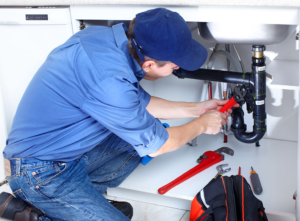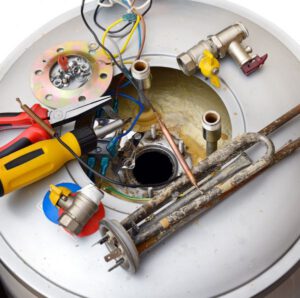Olmsted Plumbing is a highly skilled and well-paying profession. It also offers a high level of job satisfaction, especially for those who are self-employed.
Plumbing includes all the pipes, fixtures and appliances that deliver water and gas into a building and remove waste. It also refers to process piping, which conveys chemicals, gases and water for manufacturing purposes.

Valves are mechanical devices that control the flow of water through pipes. There are various types of valves that each operate in a unique way and serve specific functions. These devices are made from a variety of materials, including plastic, lead-free brass, cast iron, and stainless steel. They are available in a range of sizes to suit different plumbing needs.
One of the most common types of valves in a plumbing system is a gate valve. This type of valve has a wedge-shaped metal gate that can be lowered to stop the flow of water or raised to allow it. It is easy to use and has a simple design, which makes it ideal for large pipe diameters. However, it can wear out over time and is more prone to leaking than other types of valves.
Another common type of valve is a ball valve. This valve has a perforated ball that sits inside a body with two ports. When the valve is open, water can pass through these ports freely. When it is closed, the water will be blocked by the ball. Ball valves are also easy to operate and can be used in a wide range of applications.
Other types of valves include check valves, butterfly valves, and shut-off valves. Shut-off valves are usually located at the water meter or near the main water line and are used to shut off the water supply to the entire house. They are also found in each bathroom and kitchen fixture to shut off the water supply to that particular fixture.
A check valve is a flap that blocks one port while allowing water to flow through the other port. It is activated by water pressure and closes when the water is turned off. These valves are often used in residential and commercial buildings to prevent backflow of water and maintain pressure.
Another common type of valve is a plug valve. These valves have a disk that sits on a ring seat inside and has ports around it. The ports can be designed to have a rectangular, diamond, or round shape. A plug valve with a round port can be used for unimpeded flow, whereas a diamond or rectangular-shaped valve is better for restricting the flow of water.
Flow Rate
The volume of water passing in a pipe at a particular time is known as its flow rate. In plumbing, this is measured in gallons per minute (GPM). The higher the flow rate, the more water passes through the pipe in a given time period.
The flow rate is affected by both the width of the pipes and the amount of pressure surging through them. The smaller the pipe’s width, the lower the flow rate. The greater the pressure, the more the flow rate increases.
A common way to measure your household water flow is to place a container under each faucet and time how long it takes for the water in the container to fill. Then, multiply the total amount of time by the flow rate and divide that number by the number of minutes in an hour. This is an approximate method of determining your average water flow rate, though you can also purchase a water meter to display the exact flow rate of each fixture.
To determine the maximum water flow rate in your home, you will need to add up the service and peak flows for all of your fixtures. Service flow rates are what you experience on a daily basis, while peak flows are how much water would be flowing if every shower, toilet and appliance in your house was running simultaneously. In most residential areas, it is recommended that you limit your water peak flow to 8 ft/s.
There is a direct relationship between water flow and water pressure, so when one is altered the other will change as well. For example, low water pressure will decrease the flow rate, as there will be less force to push the water through the pipes. This is why it is important to perform regular maintenance on your plumbing system, so problems can be fixed before they become major issues.
While there are many different factors that affect water flow, water pressure is the most crucial. The pressure is a result of the weight of the water in your home’s pipes and the distance it travels to reach each fixture. It is also affected by the height of your building, as gravity will pull the water down to lower elevations.
Nominal Pipe Size
When working with pipes, it is important to know what the actual size of the pipe is. This is especially true when selecting fittings and valves. If the fit is too loose, the flow rate will be reduced, while if the fit is too tight, then the pressure can be increased and even cause damage to the pipe itself. It is not always easy to determine a pipe’s exact diameter, since it often doesn’t conform to any standard outside dimensions and the inside diameter of the pipe can vary considerably depending on the wall thickness of the pipe.
To address this issue, there is a system that has been developed to help engineers and plumbers distinguish between the various sizes of pipes. This system is called Nominal Pipe Size, or NPS, and it includes a number that refers to the outside diameter of the pipe as well as another non-dimensional designation for wall thickness referred to as “schedule.” Pipes with thicker walls are classified as having higher schedule numbers. This is because as industrial requirements to handle different temperatures and pressures have risen, the walls of pipes have become progressively thicker. This is done to increase the mechanical strength of the pipe to handle the different service requirements.
In the NPS system, for a given pipe diameter the outside diameter of the pipe remains constant. However, as the pipe schedule increases the ID of the pipe will vary. This is because as the pipe schedule gets higher, the wall thickness of the pipe will be thicker, and the internal diameter will decrease.
In the European industrial market, a system that is based on millimeters is used instead of NPS. This system is called Nominal Diameter or DN, and it also includes a number that refers to the pipe’s outer diameter as well as a number for the approximate internal diameter of the pipe. This is calculated by dividing the OD of the pipe by 2 and then multiplying the result by the appropriate pipe schedule number. Pipes with larger outside diameters will have a lower DN number.
Pipe Materials
The type of pipe material you choose has a significant impact on the performance and longevity of your plumbing system. Different materials offer a range of benefits, including durability, cost and ease of installation. Understanding how these factors impact your decision can help you select the best piping for your project.
Plastic pipes are one of the most common types of plumbing pipe. PVC is an inexpensive and durable option that’s suitable for a wide range of applications, from drain lines to potable water transport. PVC is also available in several colors to match your bathroom décor. For the safest and highest quality piping for drinking water, look for CPVC, which has an extra chlorine treatment to prevent bacterial growth within the pipe.
Metal pipes are another popular piping option. Copper pipe lasts upward of 50 years and is often found in older homes. Copper is highly resistant to corrosion, making it ideal for hot water lines. It is also non-toxic, which makes it a safer alternative to other types of pipe for delivering potable water.
Stainless steel is also a viable option for plumbing. It has a high strength-to-weight ratio, which reduces your overall piping costs. It’s also durable and corrosion-resistant, so it’s suitable for a range of applications, from drain lines to vent stacks. It’s important to note that, unlike other piping options, stainless steel is not recommended for use with acidic or salty water.
Process conditions that can affect the choice of piping material include temperature, pressure and chemical resistance. Most fluids fall into corrosive or non-corrosive categories, and you require different piping materials for each. For example, seawater is corrosive while lube oil and air are not.
Other piping materials that can be used for plumbing projects include ductile cast iron, galvanized steel and black iron. Black iron was once a popular piping choice for water supply lines, but today it’s most commonly used for conveying natural gas or propane, and for fire sprinkler systems. It’s also a good option for underground piping since it has excellent heat resistance.

